2010 Hyundai Genesis Coupe engine
[x] Cancel search: enginePage 310 of 322
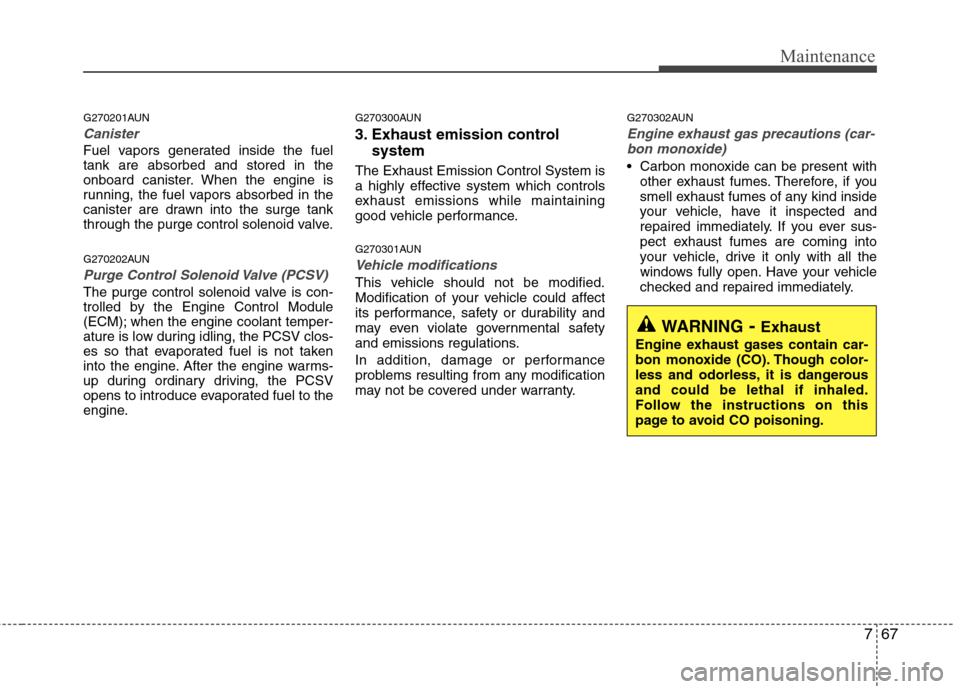
767
Maintenance
G270201AUN
Canister
Fuel vapors generated inside the fuel tank are absorbed and stored in the
onboard canister. When the engine is
running, the fuel vapors absorbed in the
canister are drawn into the surge tank
through the purge control solenoid valve.
G270202AUN
Purge Control Solenoid Valve (PCSV)
The purge control solenoid valve is con-
trolled by the Engine Control Module
(ECM); when the engine coolant temper-
ature is low during idling, the PCSV clos-
es so that evaporated fuel is not taken
into the engine. After the engine warms-
up during ordinary driving, the PCSV
opens to introduce evaporated fuel to the
engine.G270300AUN
3. Exhaust emission control
system
The Exhaust Emission Control System is
a highly effective system which controls
exhaust emissions while maintaining
good vehicle performance.
G270301AUN
Vehicle modifications
This vehicle should not be modified.
Modification of your vehicle could affect
its performance, safety or durability and
may even violate governmental safety
and emissions regulations.
In addition, damage or performance
problems resulting from any modification
may not be covered under warranty. G270302AUN
Engine exhaust gas precautions (car-
bon monoxide)
Carbon monoxide can be present with other exhaust fumes. Therefore, if you
smell exhaust fumes of any kind inside
your vehicle, have it inspected and
repaired immediately. If you ever sus-
pect exhaust fumes are coming into
your vehicle, drive it only with all the
windows fully open. Have your vehicle
checked and repaired immediately.
WARNING - Exhaust
Engine exhaust gases contain car-
bon monoxide (CO). Though color-
less and odorless, it is dangerousand could be lethal if inhaled.
Follow the instructions on this
page to avoid CO poisoning.
Page 311 of 322
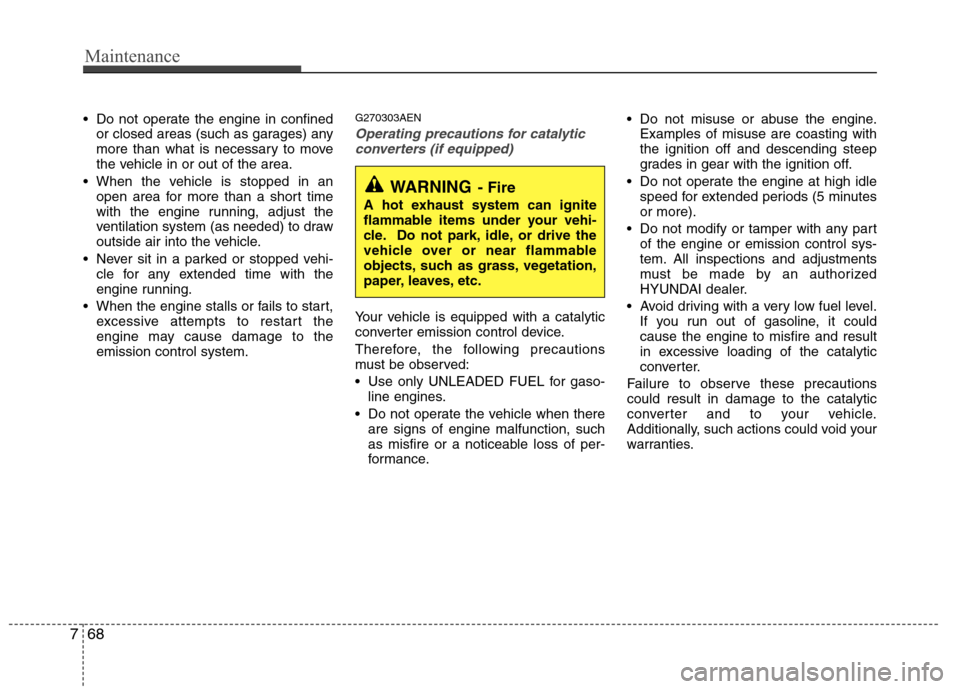
Maintenance
68
7
Do not operate the engine in confined
or closed areas (such as garages) any
more than what is necessary to move
the vehicle in or out of the area.
When the vehicle is stopped in an open area for more than a short time
with the engine running, adjust the
ventilation system (as needed) to draw
outside air into the vehicle.
Never sit in a parked or stopped vehi- cle for any extended time with the
engine running.
When the engine stalls or fails to start, excessive attempts to restart the
engine may cause damage to theemission control system. G270303AENOperating precautions for catalytic
converters (if equipped)
Your vehicle is equipped with a catalytic
converter emission control device.
Therefore, the following precautions
must be observed:
Use only UNLEADED FUEL for gaso- line engines.
Do not operate the vehicle when there are signs of engine malfunction, such
as misfire or a noticeable loss of per-
formance. Do not misuse or abuse the engine.
Examples of misuse are coasting withthe ignition off and descending steep
grades in gear with the ignition off.
Do not operate the engine at high idle speed for extended periods (5 minutesor more).
Do not modify or tamper with any part of the engine or emission control sys-
tem. All inspections and adjustments
must be made by an authorized
HYUNDAI dealer.
Avoid driving with a very low fuel level. If you run out of gasoline, it couldcause the engine to misfire and result
in excessive loading of the catalytic
converter.
Failure to observe these precautionscould result in damage to the catalytic
converter and to your vehicle.
Additionally, such actions could void your
warranties.
WARNING - Fire
A hot exhaust system can ignite
flammable items under your vehi-
cle. Do not park, idle, or drive the
vehicle over or near flammable
objects, such as grass, vegetation,
paper, leaves, etc.
Page 312 of 322
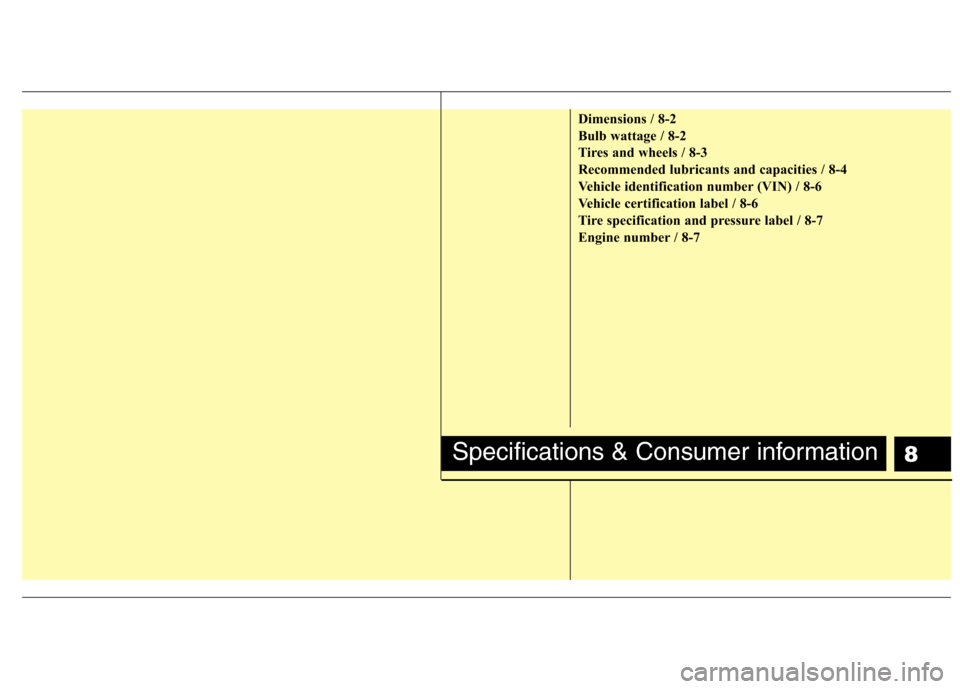
8
Dimensions / 8-2
Bulb wattage / 8-2
Tires and wheels / 8-3
Recommended lubricants and capacities / 8-4
Vehicle identification number (VIN) / 8-6
Vehicle certification label / 8-6
Tire specification and pressure label / 8-7
Engine number / 8-7
Specifications & Consumer information
Page 315 of 322
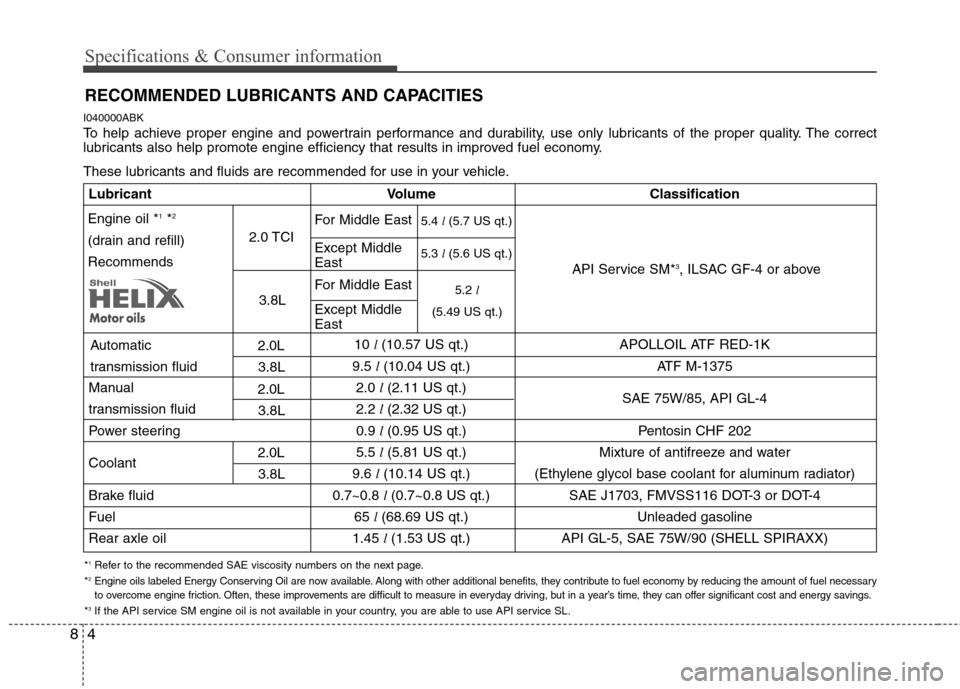
Specifications & Consumer information
4
8
RECOMMENDED LUBRICANTS AND CAPACITIES
I040000ABK
To help achieve proper engine and powertrain performance and durability, use only lubricants of the proper quality. The correct
lubricants also help promote engine efficiency that results in improved fuel economy.
These lubricants and fluids are recommended for use in your vehicle.
* 1
Refer to the recommended SAE viscosity numbers on the next page.
* 2
Engine oils labeled Energy Conserving Oil are now available. Along with other additional benefits, they contribute to fuel economy by reducing the amount of fuel necessary
to overcome engine friction. Often, these improvements are difficult to measure in everyday driving, but in a year’s time, they can offer significant cost and energy savings.
*3
If the API service SM engine oil is not available in your country, you are able to use API service SL.
Lubricant Volume Classification
10 l (10.57 US qt.) APOLLOIL ATF RED-1K
9.5 l (10.04 US qt.) ATF M-1375
Manual 2.0 l (2.11 US qt.)
SAE 75W/85, API GL-4
transmission fluid 2.2 l (2.32 US qt.)
Power steering 0.9 l (0.95 US qt.) Pentosin CHF 202
Coolant 5.5
l (5.81 US qt.) Mixture of antifreeze and water
9.6 l (10.14 US qt.) (Ethylene glycol base coolant for aluminum radiator)
Brake fluid 0.7~0.8 l (0.7~0.8 US qt.) SAE J1703, FMVSS116 DOT-3 or DOT-4
Fuel 65 l (68.69 US qt.) Unleaded gasoline
Rear axle oil 1.45 l (1.53 US qt.) API GL-5, SAE 75W/90 (SHELL SPIRAXX)
Engine oil * 1
*2
(drain and refill) Recommends 2.0 TCI
3.8L
Automatic
transmission fluid
2.0L3.8L
2.0L
3.8L
2.0L
3.8L API Service SM*
3
, ILSAC GF-4 or above5.4 l (5.7 US qt.)
5.3 l (5.6 US qt.)
5.2 l
(5.49 US qt.)
Except Middle East
For Middle East
Except MiddleEast
For Middle East
Page 316 of 322

85
Specifications & Consumer information
I040100AUN Recommended SAE viscosity
number Engine oil viscosity (thickness) has an
effect on fuel economy and cold weather
operating (engine start and engine oil
flowability). Lower viscosity engine oils
can provide better fuel economy and cold
weather performance, however, higher
viscosity engine oils are required for sat-
isfactory lubrication in hot weather. Using
oils of any viscosity other than those rec-ommended could result in engine dam-
age.When choosing an oil, consider the range
of temperature your vehicle will be oper-
ated in before the next oil change.Proceed to select the recommended oil
viscosity from the chart.
CAUTION
Always be sure to clean the area
around any filler plug, drain plug, or
dipstick before checking or drain-ing any lubricant. This is especiallyimportant in dusty or sandy areas
and when the vehicle is used on unpaved roads. Cleaning the plugand dipstick areas will prevent dirt and grit from entering the engine and other mechanisms that could
be damaged.
Temperature Range for SAE Viscosity Numbers
Temperature
Gasoline
Engine Oil (3.8L) * 1
Gasoline
Engine Oil (2.0 TCI) °C
(°F)-30 -20 -10 0 10 20 30 40 50 -10 0 20 40 60 80 100 120
*1
: For better fuel economy, it is recommended to use the engine oil of a viscosity grade SAE 5W-
20* 3
(API SM / ILSAC GF-4). However, if the engine oil is not available in your country, select
the proper engine oil using the engine oil viscosity chart.
* 2
: In Middle East, do not use the engine oil of viscosity grade SAE 5W-20.
20W-50
10W-30
15W-40
5W-20* 3
(5W-30)
5W-30, 5W-40, 5W-20* 2
Page 318 of 322
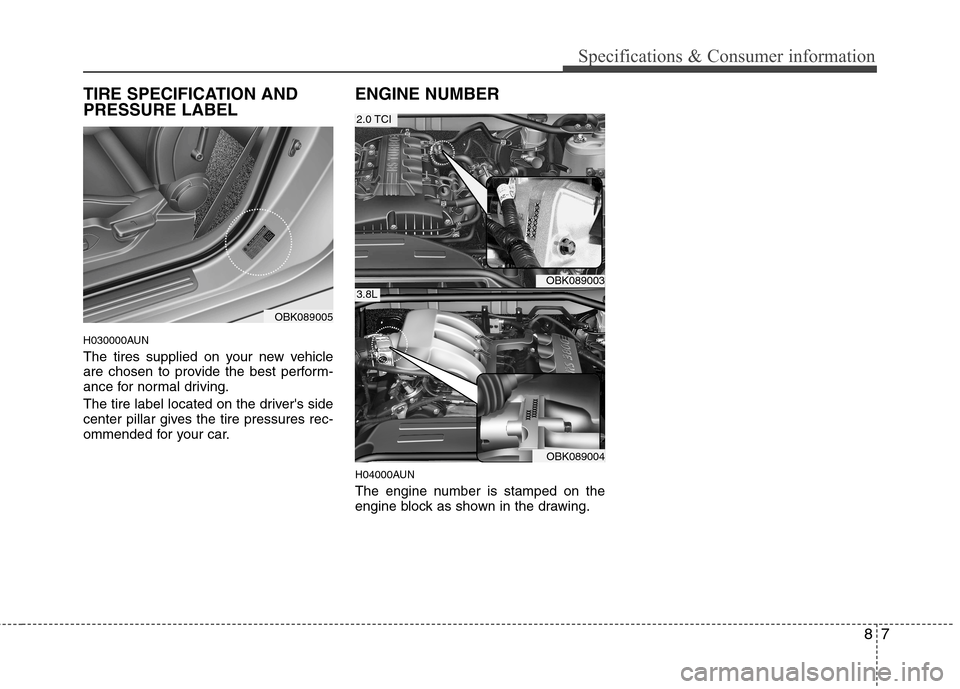
87
Specifications & Consumer information
TIRE SPECIFICATION AND PRESSURE LABEL
H030000AUN
The tires supplied on your new vehicle
are chosen to provide the best perform-
ance for normal driving.
The tire label located on the driver's side
center pillar gives the tire pressures rec-
ommended for your car.ENGINE NUMBER
H04000AUN
The engine number is stamped on the
engine block as shown in the drawing.
OBK089003
OBK089004
3.8L
2.0 TCI
OBK089005
Page 320 of 322

Index
2
I
Air bag - supplemental restraint system ······················ 3-33
Air cleaner ··································································· 7-25
Appearance care ·························································· 7-60
Audio system ······························································· 4-97
Automatic climate control system ······························· 4-77
Automatic transmission ··············································· 5-16
Automatic transmission fluid ······································ 7-23
Battery ········································································· 7-31
Before driving ································································ 5-3
Brake and clutch fluid ················································· 7-21
Brake system ······························································· 5-22
Bulb wattage ·································································· 8-2
Child restraint system ·················································· 3-24
Climate control air filter ·············································· 7-26
Cruise control system ·················································· 5-32
Defroster ······································································ 4-67
Dimensions ···································································· 8-2
Door locks ··································································· 4-14 Economical operation ·················································· 5-36
Emergency commodity ················································ 6-19
Emergency starting ························································ 6-4
Emission control system ·············································· 7-66
Engine compartment ·············································· 2-4, 7-2
Engine coolant ····························································· 7-18
Engine number ······························································· 8-7
Engine oil ····································································· 7-17
Engine Start/Stop button ················································ 5-7
Explanation of scheduled maintenance items ············· 7-14
Fuel filler lid ································································ 4-25
Fuel requirements ·························································· 1-2
Fuses ············································································ 7-44
Hazard warning flasher ················································ 4-56
Hood ············································································ 4-24
How to use this manual ················································· 1-2
A
B
C
D
E
F
H
Page 321 of 322

I3
Index
If the engine overheats ·················································· 6-6
If the engine will not start ············································· 6-3
If you have a flat tire ····················································· 6-7
In case of an emergency while driving ·························· 6-2
Indicator symbols on the instrument cluster ················· 1-5
Instrument cluster ························································ 4-37
Instrument panel overview ············································ 2-3
Interior features ··························································· 4-92
Interior light ································································· 4-65
Interior overview ··························································· 2-2
Key ················································································· 5-4
Keys ··············································································· 4-3
Light bulbs ··································································· 7-53
Lighting ······································································· 4-57
Maintenance services ····················································· 7-4
Manual climate control system ··································· 4-68
Manual transmission ···················································· 5-12
Manual transmission fluid ··········································· 7-23
Mirrors ········································································· 4-33 Owner maintenance ······················································· 7-5
Parking brake ······························································· 7-24
Power steering fluid ····················································· 7-22
Rear parking assist system ·········································· 4-54
Recommended lubricants and capacities ······················· 8-4
Remote keyless entry ····················································· 4-8
Road warning ································································· 6-2
Scheduled maintenance service ····································· 7-7
Seat belts ······································································ 3-14
Seats ··············································································· 3-2
Smart key ······································································· 4-5
Special driving conditions ··········································· 5-38
Steering wheel ····························································· 4-31
Storage compartment ··················································· 4-90
Sunroof ········································································ 4-28
I
K
L
M
O
P
R
S